Longues-sur-Mer
The Funnies concept
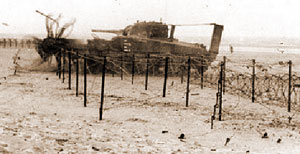
Sherman M4-D4 Crab flegeltank.
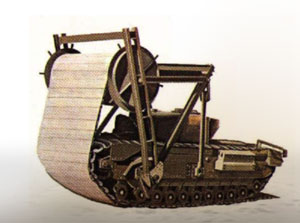
Churchill MK-III Bobbin.
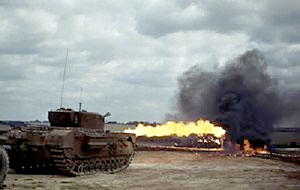
Churchill MK-VII Crocodile.
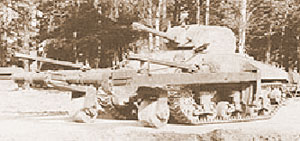
Churchill «Bangalore Torpedo» AVRE used to breach barbed-wire defences and minefields.
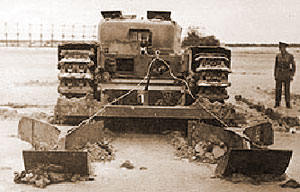
Churchill AVRE fitted with mine clearing with ploughs.
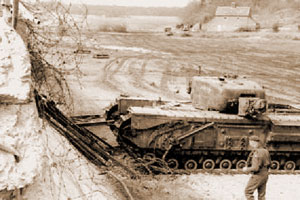
Churchill AVRE Goat Demolition.
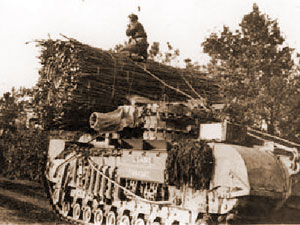
Churchill AVRE with fascine mounted.
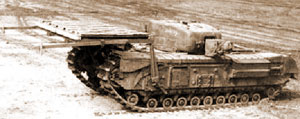
This is one of a number of devices, blessed with codenames such as Goat, Carrot and Onion which placed demolition charges against walls.
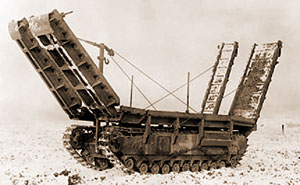
Churchill ARK.


Sherman M4-D4 Crab flegeltank.

Churchill MK-III Bobbin.

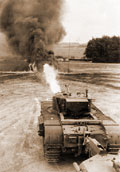
Churchill MK-VII Crocodile.

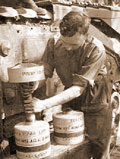

Churchill MK-III AVRE.

Canadian Indestructible Roller Device.

Fascines.

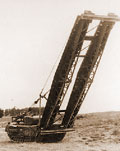
Small Box Girder Bridge.
Sherman M4-D4 Crab flegeltank
This tank saw its first action in North Africa; however D-day would be the first operation in which it would be used on a large scale. The idea for this tank cam forms the South African major A.S. du Toit. The crab was a normal Sherman tank with the one exception that it had a large drum in front of it with chains attached to the drum. The tank driver could spin the drum, so that the chains would bang on the ground in front of the tank. These chains would explode any mines that might be their on a safe distance in front of the tank. The tank could clear a safe passage through a minefield of 9 ft wide. On the back sides were 2 containers filled up with chalk powder in order to give the soldiers the limits of the cleared path.
Churchill MK-III Bobbin
Special units of the British navy landed on the Normandy beached and took samples of sand with them. From this the Intelligence concluded that at least part of the beach would be too soft to support the heavy weight of tanks. The Bobbin was a Churchill tank that would lay a large wooden carpet on the beach. The carpet was 9 ft wide and 340 ft long. The carpet would also cover the barbed wire which would facilitate the infantry in crossing the barbed wire. After the whole carpet was laid, the tank could get rid of the drum that had carried the carpet, by blowing up small explosives. The Churchill tank could then be of further service as a normal tank.
Churchill MK-VII Crocodile
On this tank the machinegun was replaced by a flamethrower. 800 of them were produced. This canon was fuelled by a cart which the tank towed behind it. The cart was an armored 2 wheel trailer and contained 400 gallons plus 5 nitrogen bottles that supplied pressure. If the trailer was hit, there was a quick release available. The crocodile could produce a beam of flames up to 150 yards in length. This weapon would prove to be very effective against small bunkers and machine gun posts. One is exposed in the Bayeux museum front yard, next to a Sherman destroyer.
Churchill MK-III AVRE (Armoured Vehicle Royal Engineers)
The tank was equipped with a 40-pound Petard-mortar. It had a range of two hundred yards. This tank could carry an SBG, a «Small Box Girder», this was a small bridge element in order to bypass tank walls and ditches. Instead of a SBG, huge bundles of wood were also carried by these tanks for the same purpose.
Canadian Indestructible Roller Device
It consisted of two arms attached to the side of the tank, each supporting a heavy roller. The roller was suspended in such a way it could jump in the air and rotate in an arc round the arm when a mine was detonated, thus reducing the chance of the rollers being blown off. Because of this construction, it did not have a limited life like the Crab on which chains which wore out or were blown off. It also had a higher speed, 5-7 mph and up to 15 on roads, and was therefore essentially a reconnaissance vehicle which could proceed at normal speeds.
Fascines
Fascines consisted of bundles of brushwood and were developed for the crossing of ditches, craters and similar obstacles. They were carried on the front of AVRE on a specially designed cradle and could be jettisoned from inside the vehicle. The bundles were 6 ft or 8 ft in diameter and 11 ft wide. However, the original positioning when being transported completely obscured the driver's view and it was frequently necessary for another crewman to stand on the fascine and relay instructions to the driver.
Tests were carried out with a periscope, but a re-design of the fascine and its cradle improved the situation and this idea was dropped.
Bridges
Most spectacular of all was the 30 foot long Small Box Girder Bridge, suspended from the nose of the tank to be dropped over an obstacle as required.
An important role for the AVRE in Normandy was as a carrier/launcher for the Small Box Girder (SBG) assault bridge. These bridges were placed against sea walls to enable them to be surmounted by armoured vehicles, or placed over shell or bomb craters and over anti-tank ditches and natural obstacles such as watercourses.
Sherman AVRE mounted with a folding Small Box Girder bridge Log Carpet. This comprised of a carpet of up to 100 logs, each 14 ft long, with an average diameter of 6 - 8 in, laid side by side and joined with wire rope passed through each log. The carpet was carried on a steel frame, mounted above the AVRE turret, and held in place with wire lashings at the forward end. After positioning the AVRE, small charges were fired to cut these cables and the first section of the carpet fell towards the ground. The weight of this pulled further logs off the frame in front of the AVRE and when the first few had reached ground level, the AVRE drove slowly forward over the logs until the entire length of the carpet had been laid. The length of carpet was up to about 80 ft.
Churchill ARK
This was a turretless Churchill tank with ramps at either end and along the body to form a mobile bridge. The Mark 1 ARK had 2' wide track ways over the tracks for vehicles to drive along and the vehicle would lower ramps by a quick release, while the Mark 2 ARK was an improvised version and crossing vehicles drove directly on the Churchill's tracks. There were two versions of the Mark 2, with one the «UK Pattern» having wider track ways than the ARK MK 1 which were now 4ft wide and the «Italian Pattern» which was the «UK Pattern» tank, but used US ramps which were either 12' 3.5'' (MK 2) or 15' 1'' (MK 1) wide. These had no built-up track ways, with the vehicles tracks being used and these were produced by converting MK IIIs in Italy.
The bridge specification was: |
|
Weight |
4 tons |
Carrying capacity |
40 tons |
Length |
34 ft |
Maximum span |
30 ft |
Maximum obstacle height |
15 ft |